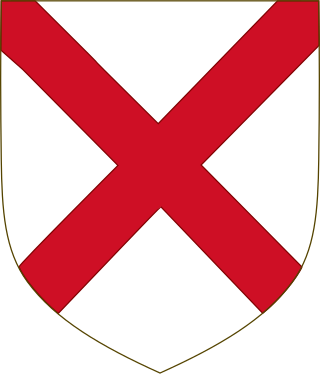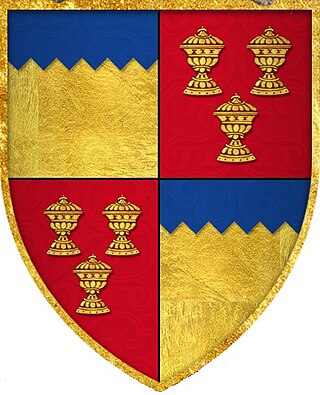
Duke of Leinster is a title in the Peerage of Ireland and the premier dukedom in that peerage. The subsidiary titles of the Duke of Leinster are: Marquess of Kildare (1761), Earl of Kildare (1316), Earl of Offaly (1761), Viscount Leinster, of Taplow in the County of Buckingham (1747), Baron of Offaly, Baron Offaly (1620) and Baron Kildare, of Kildare in the County of Kildare (1870). The viscounty of Leinster is in the Peerage of Great Britain, the barony of Kildare in the Peerage of the United Kingdom, and all other titles in the Peerage of Ireland. The courtesy title of the eldest son and heir of the Duke of Leinster is Marquess of Kildare. The Duke of Leinster is the head of the House of Kildare.

Thomond, also known as the kingdom of Limerick, was a kingdom of Gaelic Ireland, associated geographically with present-day County Clare and County Limerick, as well as parts of County Tipperary around Nenagh and its hinterland. The kingdom represented the core homeland of the Dál gCais people, although there were other Gaels in the area such as the Éile and Eóganachta, and even the Norse of Limerick. It existed from the collapse of the Kingdom of Munster in the 12th century as competition between the Ó Briain and the Mac Cárthaigh led to the schism between Thomond and Desmond. It continued to exist outside of the Anglo-Norman-controlled Lordship of Ireland until the 16th century.

The FitzGerald dynasty is a noble and aristocratic dynasty of Cambro-Norman and Anglo-Norman origin. They have been peers of Ireland since at least the 13th century, and are described in the Annals of the Four Masters as having become "more Irish than the Irish themselves" or Gaels, due to assimilation with the native Gaelic aristocratic and popular culture. The dynasty has also been referred to as the Geraldines and Ireland's largest landowners. They achieved power through the conquest of large swathes of Irish territory by the sons and grandsons of Gerald de Windsor. Gerald de Windsor was the first Castellan of Pembroke Castle in Wales, and became the male progenitor of the FitzMaurice and FitzGerald Dynasty. His father, Baron Walter FitzOther, was the first Constable and Governor of Windsor Castle for William the Conqueror, and was the Lord of 38 manors in England, making the FitzGeralds one of the "service families" on whom the King relied for his survival.
The Lord Deputy was the representative of the monarch and head of the Irish executive under English rule, during the Lordship of Ireland and then the Kingdom of Ireland. He deputised prior to 1523 for the Viceroy of Ireland. The plural form is Lords Deputy.

Thomas FitzGerald, 10th Earl of Kildare, also known as Silken Thomas, was a leading figure in 16th-century Irish history.

Piers Butler, 8th Earl of Ormond, 1st Earl of Ossory also known as Red Piers, was from the Polestown branch of the Butler family of Ireland. In the succession crisis at the death of Thomas Butler, 7th Earl of Ormond he succeeded to the earldom as heir male, but lost the title in 1528 to Thomas Boleyn. He regained it after Boleyn's death in 1538.

RaymondFitz William Fitz Gerald, nicknamed Le Gros, was a Cambro-Norman commander during the Norman invasion of Ireland. Raymond was among the first of a small band of Norman knights who landed on the South coast of Ireland before being reinforced by a larger force led by Richard de Clare, 2nd Earl of Pembroke. He was active consolidating Norman rule over Ireland before he retired to his estates in Waterford where he died in the late 12th century.
The Battle of Knockdoe took place on 19 August 1504 at Knockdoe, in the Parish of Lackagh, County Galway, between two Anglo-Irish lords—Gerald FitzGerald, Earl of Kildare, the Lord Deputy of Ireland, and Ulick Fionn Burke, 6th Clanricarde (d.1509)—along with their respective Irish allies. The cause was a dispute between Maelsechlainn mac Tadhg Ó Cellaigh (O'Kelly), King of Ui Maine – Mod. Irish Uí Mháine) and Clanricarde. The major contemporary sources for this battle are the Gaelic Irish annals and a sixteenth-century manuscript written in the Pale known as "the Book of Howth".

Gerard FitzGerald, 9th Earl of Kildare, was a leading figure in 16th-century Irish History. In 1513 he inherited the title of Earl of Kildare and position of Lord Deputy of Ireland from his father.
George FitzGerald, 16th Earl of Kildare was known as the "Fairy Earl", apparently for no other reason than that his portrait, which is extant, was painted on a small scale."
Events from the year 1487 in Ireland.
Events from the year 1504 in Ireland.
Events from the year 1534 in Ireland.
Events from the year 1597 in Ireland.
Brian Sreamhach Ua Briain, also known as Briain Catha-an-Aonaigh Ó Briain, and Brian Ó Briain, was King of Thomond from 1369 to 1400. He was the son of Mathghamhain Maonmhaighe Ó Briain. In about 1370 or 1371, he defeated and captured Gerald FitzGerald, 3rd Earl of Desmond near Limerick. On his death in 1400 he was succeeded by his brother Conchobhar, who was succeeded on his death in 1426 by Brian's son Tadhg na Glaoidh Mór.

Henry O'Brien, 5th Earl of ThomondPC (Ire) (1588–1639), styled Lord Ibrickane until 1624, was summoned to the House of Lords of the Irish Parliament of 1613–1615.
Sir Thomas FitzGerald of Laccagh (c.1458–1487) was an Irish lawyer, statesman and soldier who was Lord Chancellor of Ireland under Richard III and Henry VII, but rebelled against Henry and was killed at the Battle of Stoke.
Essex Digby was an English Anglican priest in Ireland in the second half of the seventeenth century.
Events from the year 1523 in Ireland.
Events from the year 1312 in Ireland.








